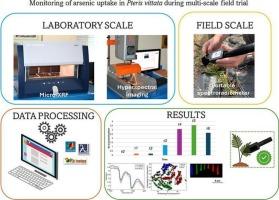Monitoring of arsenic uptake in Pteris vittata using short-wave infrared spectroscopy during multi-scale field trial
IF 4.6
2区 化学
Q1 SPECTROSCOPY
Spectrochimica Acta Part A: Molecular and Biomolecular Spectroscopy
Pub Date : 2025-09-19
DOI:10.1016/j.saa.2025.126964
引用次数: 0
Abstract
In this study an innovative multi-analytical approach to monitor arsenic (As) accumulation in Pteris vittata, using hyperspectral imaging (HSI) in the short-wave infrared range (SWIR: 1000–2500 nm), micro-X-ray fluorescence (micro-XRF) and spectroradiometric measurements obtained with a portable device, have been applied. The objective was to establish a reliable and non-invasive strategy for tracking As uptake dynamics and related physiological changes in plants under both controlled and field conditions. To this end, 28 ferns were planted in an As-contaminated soil and monitored for up to 120 days. The study was structured into three phases. First, micro-XRF was used to monitor As accumulation kinetics in the pinnae of a representative number of plants. In the second phase, the same pinnae were also analyzed using HSI to characterize spectral signatures related to As induced stress and to explore spectral variability through t-distributed Stochastic Neighbor Embedding (t-SNE). This analysis revealed specific spectral patterns linked to As accumulation. An ECOC-SVM-based classification model was then developed using HSI data to assess As amounts in laboratory scale. In the third phase, based on the spectral features and classification approach developed by HSI, a new ECOC-SVM classifier was produced using all the data acquired by a portable spectroradiometer in all field-grown plants. The results confirmed that micro-XRF efficiently tracked As accumulation, while HSI identified distinct spectral signatures associated with As induced stress. The t-SNE analysis demonstrated variability in spectral responses, which facilitated the development and classes set of a robust ECOC-SVM model. Importantly, applying the ECOC-SVM model to the portable spectroradiometer data demonstrated its effectiveness in real-time monitoring of As phytoextraction at field-scale. This multi-analytical approach provides an efficient and scalable tool for optimizing phytoremediation strategies and environmental monitoring, confirming its reliability in both laboratory and field settings.

多尺度田间试验中短波红外光谱法监测维塔蒿对砷的吸收
本研究采用了一种创新的多分析方法,利用短波红外(SWIR: 1000-2500 nm)高光谱成像(HSI)、微x射线荧光(micro-XRF)和便携式仪器获得的光谱辐射测量,监测了vittata中砷(As)的积累。目的是建立一种可靠的、无创的策略来跟踪受控和田间条件下植物对砷的吸收动态和相关生理变化。为此,在砷污染的土壤中种植了28种蕨类植物,并对其进行了长达120天的监测。这项研究分为三个阶段。首先,利用微量xrf技术监测了砷在典型植物羽部的积累动力学。在第二阶段,我们还使用HSI分析了相同的尾音,以表征与砷诱导应力相关的光谱特征,并通过t分布随机邻居嵌入(t-SNE)探索光谱变异性。该分析揭示了与砷积累有关的特定光谱模式。然后,使用HSI数据开发了基于ecoc - svm的分类模型,以评估实验室规模的砷含量。在第三阶段,基于HSI开发的光谱特征和分类方法,利用便携式光谱辐射计在所有田间种植植物中获取的所有数据,生成新的ECOC-SVM分类器。结果证实,micro-XRF有效地跟踪了砷的积累,而HSI识别了与砷诱导应力相关的独特光谱特征。t-SNE分析显示了光谱响应的可变性,这促进了稳健的ECOC-SVM模型的开发和分类集。重要的是,将ECOC-SVM模型应用于便携式光谱辐射计数据,证明了其在现场尺度上实时监测As植物提取的有效性。这种多分析方法为优化植物修复策略和环境监测提供了有效和可扩展的工具,证实了其在实验室和现场设置中的可靠性。
本文章由计算机程序翻译,如有差异,请以英文原文为准。
求助全文
约1分钟内获得全文
求助全文
来源期刊
CiteScore
8.40
自引率
11.40%
发文量
1364
审稿时长
40 days
期刊介绍:
Spectrochimica Acta, Part A: Molecular and Biomolecular Spectroscopy (SAA) is an interdisciplinary journal which spans from basic to applied aspects of optical spectroscopy in chemistry, medicine, biology, and materials science.
The journal publishes original scientific papers that feature high-quality spectroscopic data and analysis. From the broad range of optical spectroscopies, the emphasis is on electronic, vibrational or rotational spectra of molecules, rather than on spectroscopy based on magnetic moments.
Criteria for publication in SAA are novelty, uniqueness, and outstanding quality. Routine applications of spectroscopic techniques and computational methods are not appropriate.
Topics of particular interest of Spectrochimica Acta Part A include, but are not limited to:
Spectroscopy and dynamics of bioanalytical, biomedical, environmental, and atmospheric sciences,
Novel experimental techniques or instrumentation for molecular spectroscopy,
Novel theoretical and computational methods,
Novel applications in photochemistry and photobiology,
Novel interpretational approaches as well as advances in data analysis based on electronic or vibrational spectroscopy.

 求助内容:
求助内容: 应助结果提醒方式:
应助结果提醒方式:


